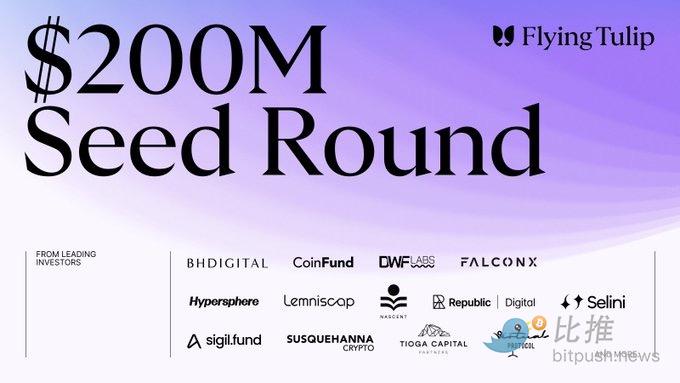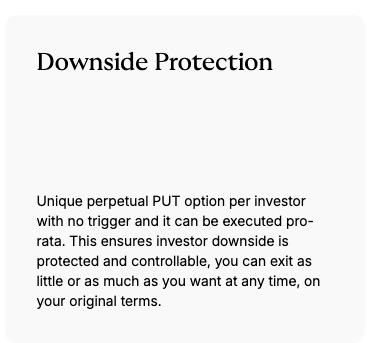Author: Bootly
When everyone thought Andre Cronje had faded out of the crypto circle, this legendary figure known as the "Father of DeFi" is back.
This time he brought a brand new project - Flying Tulip, and announced today that it has completed US$200 million in financing and plans to launch a public token sale.

Even more unique is the fact that this public offering comes with an unprecedented mechanism: users can destroy tokens and withdraw their principal at any time. This means that participants have a "bottom-line protection" for downside risk, while upside returns remain uncapped.
Who is Andre Cronje?
If you experienced the DeFi summer in 2020, you must have heard his name.
 Andre Cronje is the founder of Yearn Finance (YFI)—a legendary developer who sparked the DeFi craze with code alone. YFI was once hailed as the "fairest token" because he didn't reserve any share for himself.
Andre Cronje is the founder of Yearn Finance (YFI)—a legendary developer who sparked the DeFi craze with code alone. YFI was once hailed as the "fairest token" because he didn't reserve any share for himself.
But after several popular projects, community disputes and safety incidents, Cronje faded from the public eye in 2022. Until today, he "re-emerged" with Flying Tulip.
What is Flying Tulip?
Editor's Note: "Flying Tulip" literally means "flying tulip." Tulips are the most famous symbol of bubbles in financial history (the 17th-century "Tulip Mania" was the earliest speculative bubble).
Cronje named the project Flying Tulip, a bit of self-deprecation and a declaration: the crypto world may be like a tulip, but this time, he wants it to truly "fly." In other words, Flying Tulip aims to make what once represented a "bubble" more stable, more real, and more resilient through on-chain mechanisms.
According to official documents, Flying Tulip hopes to build a full-chain financial platform that integrates many functions familiar to crypto users - stablecoins, lending, spot trading, derivatives, options, and insurance - into one system.
Simply put, it wants to be a "one-stop DeFi platform" that allows users to:
- Deposit coins to earn income;
- Borrowing currency for leverage;
- Go long or short;
- Even hedge risks through on-chain insurance.
All of this is done in a unified account system, without the need to frequently switch between different platforms.
A "refundable" token offering
The most eye-catching thing this time is Flying Tulip’s “Onchain Redemption Right”.

Traditionally, once users participate in a token public sale, their money is locked regardless of whether the token price rises or falls.
But Flying Tulip provides a "programmatic redemption" mechanism——
All participants can destroy their $FT tokens at any time and get back their invested capital (such as ETH).
The system will automatically return funds from a separate on-chain reserve pool.
This design is a bit like an on-chain insurance mechanism, which not only ensures that investors will not lose everything, but also retains room for growth.
However, it should be noted that the official also reminded that this is not a "guaranteed return of principal" or "deposit insurance" - the size of the reserve pool is limited, and whether the redemption right can be exercised depends on whether there is sufficient funds in the pool.
Funds are not locked up: using returns to feed growth
In the roadshow materials presented to investors, Cronje mentioned that this design seems to make the funds unusable, but in fact Flying Tulip plans to invest this money in on-chain income strategies, such as mainstream DeFi protocols such as Aave, Ethena, and Spark.
Their goal is to achieve an annualized return of approximately 4%.
Based on the planned financing ceiling of US$1 billion, it will generate approximately US$40 million in interest income each year.
The proceeds will be used to:
- Payment protocol incentives;
- Buy back $FT tokens;
- Support ecological growth and market promotion.
Cronje described it in its investor materials: “We use recurring returns to drive growth and incentives, and use perpetual put options to protect investors from downside risks while retaining the token’s unlimited upside potential – this forms a self-reinforcing growth flywheel.”
The team has no reserved share
Another highlight is that the Flying Tulip team did not have any initial token allocation.
Their income all comes from the real profits of the project, which they use to repurchase $FT tokens on the market and release them according to the public plan.
In other words, the team can only get rewards when the protocol actually makes money and users actually use it.
This puts the team and investors in the same boat – the more popular the project, the more they earn.
A strong capital lineup, targeting US$1 billion in financing
Flying Tulip has completed $200 million in private equity funding from investors including:
- Brevan Howard Digital
- CoinFund
- DWF Labs
- FalconX
- Hypersphere
- Nascent
- Republic Digital
- Susquehanna Crypto, etc.
Next, they will launch public offerings on multiple chains simultaneously, with a target total financing of up to US$1 billion.
Summarize
The emergence of Flying Tulip reminds people of the era of 2020 when "code changed finance".
The difference is that this time, Andre Cronje's ambitions extend beyond product innovation to make DeFi more trustworthy and sustainable. After the bear market and the collapse of trust in DeFi, Cronje's return may not only be a developer's comeback, but also a signal that a new DeFi cycle is poised to be reignited.







